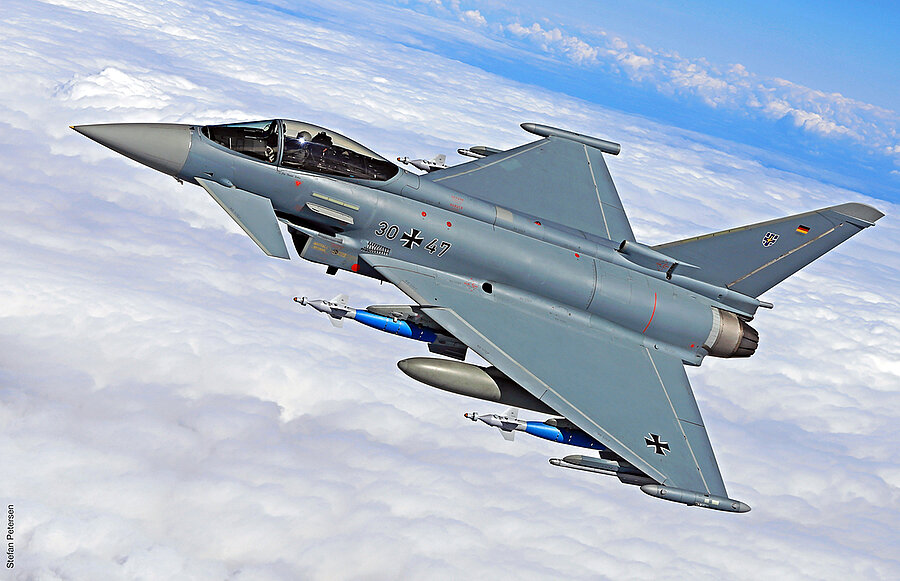Radars on-the-move: Mobile sensors, key to battlefield survivability
Featuring Spexer 2000
Recent conflicts have highlighted the significant dangers that armed forces face. Soldiers must contend with traditional threats, such as artillery barrages, as well as new technology and tactics in the form of deadly drone attacks. In this new 21st century theatre of conflict, personnel have quickly learned that early detection of threats and mobility are key to survival. We learn how HENSOLDT can help.
October 29, 2023
info@hensoldt.net
CATEGORIES:
Radar
Surveillance
Ground-based radar
SPEXER
Combat scenario in modern conflicts
An armoured vehicle is being observed from several hundred metres away. Its large turret, familiar shape and muddy track marks are clearly visible from above.
A small hostile unit operating an inexpensive off-the-shelf drone (UAV) can see that the vehicle has stopped, and the crew members are taking a break inside and around the vehicle, unaware they are being watched. It’s time to strike.
Elsewhere, a smaller drone – known as an FPV (first person view) drone – has taken off and is being navigated by a skilled operator utilizing its front-mounted camera and instructions from the intelligence-gathering drone team.
The FPV drone however is not there to surveil, but instead has an explosive device attached to it that will be able to cause significant damage to the armoured vehicle.
The crew members only realise they are in danger at the last second as the drone’s high-pitched rotors suddenly become audible. Several kilometres away, the FPV operator sees his display goes dark as the drone successfully explodes into its target.
This combat scenario has played out numerous times in recent conflicts. Commercially available drones can neutralise high-value military equipment and the lives of its operators.
Mobility remains key for protection
Stationary targets are easy targets, which is why – where possible – mobility contributes to the survivability for ground vehicles, alongside areas such as armour, protection systems and firepower.
With mobility being so important, it is a key that systems and sensors on board a vehicle also have the ability to be operated on-the-move. This is why many vehicle weapon stations and high-resolution electro-optics are stabilised with electro-mechanical systems to ensure that crews can operate on the move and not become “sitting ducks” to attacks from the ground or above.
While the importance of mobility cannot be overstated, there still needs to be a way of detecting threats early before they become an imminent threat; and when it comes to detecting ground and aerial targets, including military and commercial drones (UAVs) that are used for intelligence gathering or attack missions, radar is still a vital asset for military ground and naval units.
Radar has always been a critical asset on the battlefield since its inception nearly eight decades ago, and that’s no different today. The use of radar has expanded over time and the threat from relatively low-cost drones has only served to increase the requirement for radar-based threat detection capabilities, particularly those that can detect and classify targets with low radar cross sections and categorise and track multiple “swarming” targets.
Vehicle-based radars are an ideal solution as they are mobile and can protect formations and convoys as they move within their area of operation.
Radar and mobility: the perfect duo
Ensuring that forces remain mobile while under a protective surveillance sphere is an optimum combination for the modern battlefield. However, there remains several challenges, especially when it comes to the radar’s detection capabilities, as well as the limitations of operating a radar on a moving vehicle.
Many radar systems cannot operate effectively while moving. In addition, the radar’s detection coverage may be limited in terms of elevation range. Thus, a military unit will miss the benefit of radar surveillance both while on the move, as well as directly above their vehicle.
HENSOLDT has developed a technological solution to address these battlefield challenges, thereby protecting personnel and ensuring successful mission completion even in the most adverse conditions.
At the core of this solution is HENSOLDT’s SPEXER 2000 radar, which has been used by military and security forces across the world for nearly two decades and is one of the world’s leading radar capabilities, especially in C-UAV roles. The radar has gone through a number of iterative capability enhancements over the years to introduce new features leveraging the performance and function of modern electronics.
Its latest version MkIII is leading the way in terms of advanced battlefield capabilities.

SPEXER 2000 MkIII: a battle-winning capability
The SPEXER 2000 MkIII addresses the critical need for both battlefield mobility, as well as 3D detection capabilities, including small drones. Due to spectral-based micro-Doppler automatic target classification, the radar differentiates between various VSHORAD targets (UAVs, helicopter or birds) and ground targets. Thanks to its modern electronics, the system is more cost effective and less power intensive than previous radars allowing it to be installed on a wider range of vehicles.
The SPEXER 2000 MkIII detects and automatically classifies multiple targets in parallel, with its active electronically scanned array (AESA) in X-band, using beam steering and advanced processing capabilities. Unlike legacy radars requiring tuning and setting up, the SPEXER 2000 family operates as turned on. This is highly important in battle scenarios. There a few seconds delay can be deadly.
With a fixed panel radar covering 120 degrees in azimuth, the addition of two more panels gives operators full 360-degree coverage and no blind spots that enemy forces could exploit. This is also true for elevation, with the latest version of the SPEXER 2000 featuring 90 degrees of coverage, effectively creating a hemisphere around the vehicle and its surroundings.
At HENSOLDT we are committed to protecting the armed forces and wider societies against aggression and threats to life, and we are proud that the SPEXER 2000 MkIII contributes to this important mission.


